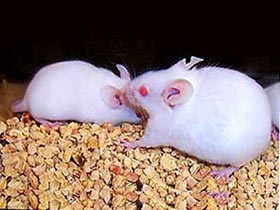Successfully raising mice with glaucoma
Japanese scientists have successfully raised mice with blinded glaucoma (glaucoma).
 The continuous experiment and research on this type of mouse will help scientists learn about the mechanism of glaucoma development and study the types of help to treat this disease.
The continuous experiment and research on this type of mouse will help scientists learn about the mechanism of glaucoma development and study the types of help to treat this disease.
Scientists at Hokkaido University said that they have adopted a gene recombination technology to successfully cultivate mice infected with glaucoma. There are no two types of Vav2 and Vav3 in this body of mice.
Genes Vav2 and Vav3 usually exist in the cornea and iris of the eye. Without this gene, the pressure in the eyeball of the mouse will naturally increase with the growth of the body, and after 10 weeks of birth, their eyeball pressure is 1.5 times more than normal mice. .
Previously, although scientists have found many genes related to glaucoma, it has not yet successfully cultured animals with natural elevated eyeball pressure and glaucoma.
Scientists say this newly cultured mouse could be used for experiments to study the mechanism of glaucoma development and help prepare drugs to treat glaucoma.
- Scientists initially recovered sight for blind mice
- The mole rats eat the mouse rat manure to get instructions for raising children
- Scientists initially recovered vision for blinded mice
- Successfully developed the glaucoma diagnostic device
- Use of cocaine is prone to blindness
- Canada studies glaucoma
- Discovered a mutant gene that causes glaucoma
- Detection of genes that cause glaucoma
- Successfully developed ultra-thin electronics
- Successfully cloned mice from a drop of blood
- An Giang successfully completed the chicken ship breeding
- Mini-rat brains in mice raise concerns about intelligent hybridization
 Why do potatoes have eyes?
Why do potatoes have eyes? 'Tragedy' the world's largest carnivorous life: Death becomes ... public toilet
'Tragedy' the world's largest carnivorous life: Death becomes ... public toilet Tomatoes were once considered 'poisonous' for 200 years
Tomatoes were once considered 'poisonous' for 200 years Detecting microscopic parasites on human face
Detecting microscopic parasites on human face